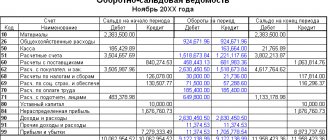Basic approaches to the classification of types, forms and methods of financial control
Financial control is a set of activities of competent economic entities that are associated with the verification and analysis of elements of the financial infrastructure, management and reporting in a particular organization.
Let us consider their essence in more detail. The form of financial control is a sign that reflects the way a particular subject of control exercises its actions. Modern Russian experts identify 3 key forms of financial control:
- preliminary;
- current;
- subsequent.
Type of financial control is a sign that allows you to classify the relevant control activities into one category or another. Current theoretical concepts suggest a classification of types of financial control on the following basic grounds:
- subject of control;
- direction of control;
- deadlines.
Thus, in fact, the corresponding types and forms of financial control can be considered as similar features. The use of this analogy can be seen in many publications of Russian experts.
The financial control method is a feature that reflects the specifics of a specific inspection tool used by the subject of financial control. There are 3 main categories:
- methods that are associated with document verification;
- methods that are associated with checking the content of the company’s activities;
- methods that are associated with competency testing.
Let us study in more detail the key features of financial control - types, forms and methods - in relation to the noted grounds for their classification.
Types of internal control
Comprehensive control includes these forms of verification activities:
- Preliminary control. Performed until the business transaction is completed. This tool provides the formation of a forecast regarding the outcome of the operation. It allows you to decide whether to take one step or another.
- Current control. Includes analysis of measures to implement the budget, generation of financial statements, analysis of the efficiency of use of funds. The compliance of the company's expenses with its goals is checked.
- Subsequent control. Carried out based on the results of completed business transactions. At the same time, accounting documentation is checked. The results of the inventory are monitored.
IMPORTANT! Current and preliminary control can be included in the current activities of employees. It makes sense to entrust subsequent control to an employee who specializes in control activities.
ATTENTION! It is advisable to carry out all types of control measures. For this purpose, departments, individual employees, and a special commission are involved in the work. However, this is only possible if the company has the appropriate resources.
Preliminary control
Preliminary control is needed to make a decision about the operation. It is dealt with by company managers, deputies, chief accountants, and representatives of the legal department. As part of preliminary control, the following activities are carried out:
- Checking the completion of financial planning papers.
- Approval and approval of documentation.
- Checking contracts.
- Examination of papers on the expenditure of company resources.
Preliminary control includes an analysis of the agreements’ compliance with the activity plan, checking all forms of reporting (budgetary, statistical, etc.) until the documents are signed.
Current control
Current control includes daily research into the expenditure of funds and filling out accounting documentation. Consists of activities such as:
- Analysis of expenditure documentation.
- Checking the amount of funds in the cash register.
- Control over the completeness of the posting of funds issued by a banking institution.
- Control over the debts of debtors and the debts of the company itself.
- Checking the compliance of analytical accounting with synthetic accounting.
- Establishing the actual existence of company property.
Current monitoring is carried out regularly. It is carried out by representatives of accounting departments.
Subsequent control
It is carried out after the completion of a particular operation. Involves checking all related documents. Let's consider methods of subsequent control:
- Inventory.
- Audit of the cash register without prior preparation.
- Checking the ways in which funds are used.
- Analysis of available documents.
Follow-up control is the final stage of internal audit. It is advisable to entrust it to a special commission. Its composition is indicated in the appropriate provision. If required, the composition can be changed. In the future, control is carried out through scheduled and unscheduled inspections.
Forms of financial control: preliminary, current, subsequent
So, there are 3 main forms of control activities - preliminary, current, and subsequent financial control.
Preliminary control involves the implementation of control actions by the subject even before the organization being inspected implements certain legally significant measures. For example, spending budget funds on certain items, if we are talking about a state or municipal organization, or investing retained earnings, if we consider the activities of commercial firms.
Preliminary control involves checking the readiness of the relevant organizations to conduct a financial event. The inspector must verify the legality of the event, as well as that its implementation satisfies the interests of affiliated persons (investors, senior managers, state, municipality). Preliminary control allows you to identify shortcomings made by the organization in terms of preparing documents necessary for the implementation of a particular event.
Current control involves checking the content of financial activities directly during the period of their implementation. Typically, such actions are associated with checking supporting documents accompanying transactions, or, for example, monitoring the quality of work of responsible departments - accounting, financial departments, warehouses, logistics services, on which the success of solving problems related to financial management of the organization depends.
Subsequent control is a set of actions of the subject of control, involving verification of financial measures that have already been implemented by the company. It helps to identify discrepancies between the results of these activities and the law, determine the validity of certain financial transactions, and formulate recommendations aimed at improving the implementation of such activities in the future.
Financial control
Financial control at an enterprise is a system of actions and operations to verify financial and related issues of the activities of business entities using special methods. The object of financial control is monetary distribution processes in the formation and use of financial resources. Including in the form of cash at different levels. The scope of financial control covers all transactions using money, and in some cases without it (barter transactions). In the process of financial control, compliance with the intended use of funds and the proportion of cost redistribution are checked
gross social product of national income, development and execution of budgets, solvency, correct payment of taxes. The tasks of financial control include ensuring compliance with the legality of financial activities, preventing insolvency and bankruptcy, identifying internal reserves, increasing the efficiency of the enterprise through more rational use of resources, checking the correctness of accounting, determining the extent of damage, and studying the possible liability of managers. Legislative and executive authorities control the activities of all economic entities using special methods. Control is being carried out
monitoring compliance with financial and economic legislation in the process of forming and using funds of funds, assessing the effectiveness of business operations and the feasibility of expenses. Financial control is designed to ensure the interests and rights of the state and its institutions. Financial violations entail sanctions and fines.
Financial control includes control by credit institutions and shareholders.
Internal control is applied - checking the effectiveness of the use of monetary resources (own, borrowed, attracted), analysis and compilation of actual financial results with predicted ones, financial assessment of the results of investment projects, reliability
financial reporting, control over financial condition. The scope of state financial control is narrowing. It concentrates on the sphere of economic processes, including control over the cost proportions of the movement of GDP, the money supply, the formation and use of funds at the disposal of the state. The scope of non-state financial control on the part of auditing and insurance firms and credit organizations is expanding. Special supervisory bodies of representative power have been created. At the level of individual economic entities, there is increasing attention to the financial examination of investment projects with the involvement of specialized consulting firms, investment banks and financial corporations.
Financial control carried out before financial transactions are carried out is called preliminary. It is carried out to prevent financial irregularities. They develop financial plans and estimates, credit and cash applications, financial sections of business plans, draw up forecast balances, constituent agreements, and joint venture agreements.
Operational financial control is carried out at the time of financial transactions. Subsequent financial control is carried out by analyzing reported financial and accounting documentation. During inspections, on the basis of reporting documentation and expenditure documents, they consider individual issues of financial activity and outline measures to eliminate identified violations. The activities of commercial banks are supervised by the Central Bank of Russia. The most profound method of financial control is audit.
Audits can be complete and partial, planned and unscheduled, documentary and factual.
The results of the audit are documented in an act, on the basis of which measures are taken to eliminate violations, compensate for material damage and bring those responsible to justice.
Based on materials from the domestic press.
D.V. Krivopalov [email protected]
Hello Guest! Offer from "Clerk"
Online professional retraining “Accountant on the simplified tax system” with a diploma for 250 academic hours . Learn everything new to avoid mistakes. Online training for 2 months, the stream starts on March 1.
Sign up
Classification of types of control by timing
Let us now study the essence of various types of financial control within the framework of the classification discussed above. Its first basis, which we examine, is the timing of the control. These may correspond to operational, scheduled, or unscheduled inspections.
Operational financial audits are distinguished, first of all, by their short duration, as well as by their fairly high frequency. They can be carried out by the subject of control once a week or monthly.
Scheduled inspections, in turn, are considered longer. They are usually held not so often - once a year, every six months, sometimes once every few years. The audited organization usually has enough time to prepare for scheduled financial control.
Operational and scheduled inspections have a common feature - the presence of a schedule for the implementation of inspections by the subjects of financial control. Even if inspections are carried out very often, for example, weekly, the company’s management, as a rule, knows in advance the specific time of the inspectors’ visit, as well as what they will study.
In turn, unscheduled inspections can be carried out without warning, carried out outside of any schedule and with any frequency. Information about what the inspectors will do, as well as what documents they may request, immediately prior to the unscheduled control may be closed to the organizations being inspected.
Levels of internal control
Internal control is carried out at these levels:
- Employee level. The employee exercises control within the scope of his official powers.
- Structural department level. Responsibility for control is assigned to department employees and department heads.
The procedure for carrying out control is regulated by the regulations on the work of the control measures department. The work of the auditor will also be regulated by this provision. The document must be approved by order of the manager. The work of the structural unit is based on it.
IMPORTANT! If Internal Control is carried out by different employees and departments, responsibility is delimited on the basis of local acts and job descriptions.
Features of internal control
In the process of carrying out control activities, the following tools are used:
- General scientific methods: analysis, deduction, etc.
- Empirical methods: inventory, surveys, measurements.
- Specific tools: probability theory, etc.
Financial control can be entrusted to a special commission or third-party companies.
Classification of types of control by subjects
The range of possible subjects of financial control is very wide. Modern Russian experts identify the following main groups:
- executive authorities (not related to law enforcement agencies);
- legislative bodies;
- banks;
- law enforcement agencies;
- auditors;
- superior organizations;
- public organizations;
- intra-corporate and departmental structures.
Let's study their specifics in more detail.
Subjects of financial control: authorities
The executive authorities that most often become subjects of control are the Ministry of Finance, the Federal Service for Financial Monitoring, the Federal Tax Service, the Federal Customs Service, state extra-budgetary funds, the Federal Treasury, as well as the structures subordinate to them vertically in the regions.
It may be noted that the competent authority often predetermines the specific name of a particular type of control. For example, the Federal Tax Service carries out tax control, the Federal Customs Service carries out customs control.
Read more about tax audits in the article “Tax audit - what is it and what is the procedure?”
As for legislative bodies, financial control is most often exercised by the Accounts Chamber, formed with the participation of both chambers of the Russian Parliament - the State Duma and the Federation Council. Accounting chambers are also being formed in the constituent entities of the Russian Federation, with the participation of regional parliaments.
Law enforcement agencies that can apply financial control are the Ministry of Internal Affairs, the FSB, and the Prosecutor General's Office. These departments also function centrally—regional ones are subordinate to federal structures.
Subjects of financial control: banks, auditors
The subject of financial control can be both the Central Bank and commercial credit institutions. At the same time, the latter are accountable to the Central Bank in terms of carrying out basic financial activities.
Auditors can be external and internal (or departmental). The former, as a rule, carry out financial control on a commercial basis, as a service. However, the results of such checks are usually provided to an external entity, for example, an investor or a bank.
Internal audit is a subtype of internal corporate or departmental financial control. Its results are usually used within a specific organization. Most often it is implemented by the company’s internal services. But sometimes firms also turn to external auditors who provide services in the form of outsourcing.
Subjects of financial control: higher structures, social activists
Financial control can be initiated and carried out by the institution to which the company or budgetary organization is accountable - holding company, central office, main department, central office, etc.
It is quite possible for public associations to initiate financial control procedures. At the same time, they can be both independent subjects of inspections (if they include competent employees capable of carrying out appropriate control), and send appeals to other subjects of control, whose work is in some way connected with the organization that has attracted the attention of public activists.
Objectives of financial control of companies
The objectives of financial control of an organization include:
- assessing the effectiveness of accounting in the organization, increasing the efficiency of accounting in case of identifying unsatisfactory accounting;
- assessing the competence and qualifications of employees, increasing their competence if their unsatisfactory competence is identified;
- assessing the effectiveness of financial management in the organization, increasing efficiency if unsatisfactory financial management is identified;
- optimization of financial management in the organization;
- identifying the reasons for effective or ineffective financial management of the organization;
- development of a more advanced financial plan for future periods of time, taking into account the results of financial control.
Classification of types of control: directions of inspections
Another basis for classifying types of financial control that Russian researchers highlight is the direction of inspections. It is represented by 3 main categories:
- document flow audits;
- technical checks;
- reporting checks.
As for the first area of financial control, inspectors in this case most often examine legally significant sources on the basis of which the organization makes certain decisions on capital management.
In the technical aspect, the infrastructure used to implement legally significant actions, for example, those related to the signing of banking and other documents using digital signatures, can be checked. This area of checks in a number of aspects may be associated with audit activities, for example, if it is necessary to determine whether the software for electronic keys complies with legal requirements.
The third direction of inspections involves the examination by the inspection structure of documents related to accounting, tax and management reporting. These can be primary documents, unified forms, forms, internal corporate sources, extracts.
Article 267.1 of the BC RF. Methods of implementing state (municipal) financial control
Budget Code>Part Three of the Budget Code of the Russian Federation. BUDGET PROCESS IN THE RUSSIAN FEDERATION>Section IX of the Budget Code of the Russian Federation. STATE (MUNICIPAL) FINANCIAL CONTROL>Chapter 26 of the Budget Code of the Russian Federation. BASICS OF STATE (MUNICIPAL) FINANCIAL CONTROL>Article 267.1. Methods of implementing state (municipal) financial control
1. The methods of exercising state (municipal) financial control are inspection, audit, inspection, and authorization of transactions.
2. For the purposes of this Code, inspection means the performance of control actions for the documentary and factual study of the legality of individual financial and business transactions, the reliability of budget (accounting) accounting and budget (accounting) reporting in relation to the activities of the object of control for a certain period.
For the purposes of this Code, an audit is understood as a comprehensive audit of the activities of the object of control, which is expressed in carrying out control actions to document and factually study the legality of the entire set of financial and business transactions, the reliability and correctness of their reflection in the budget (accounting) statements.
The results of the inspection and audit are documented in an act.
3. Inspections are divided into desk and field inspections, including counter inspections.
For the purposes of this Code, desk audits mean audits carried out at the location of the state (municipal) financial control body on the basis of budget (accounting) statements and other documents submitted at its request.
For the purposes of this Code, on-site inspections mean inspections carried out at the location of the object of control, during which, among other things, the actual compliance of the transactions performed with the data of the budget (accounting) statements and primary documents is determined.
For the purposes of this Code, counter inspections mean inspections carried out as part of on-site and (or) desk inspections in order to establish and (or) confirm facts related to the activities of the object of control.
4. For the purposes of this Code, an inspection means an analysis and assessment of the state of a certain area of activity of the object of control.
The results of the examination are formalized in a conclusion.
5. Authorization of transactions for the purposes of this Code means the execution of a permitting inscription after checking the documents submitted for the purpose of carrying out financial transactions for their availability and (or) compliance of the information specified in them with the requirements of the budgetary legislation of the Russian Federation and other regulatory legal acts governing budgetary legal relations.
< Article 267. Lost force. — Federal Law of July 23, 2013 N 252-FZ.
Article 268. Repealed. — Federal Law of July 23, 2013 N 252-FZ. >
Methods of financial control: documentary verification
This group of methods is key from the point of view of conducting audits of document flow, which we described above. According to many experts, the group of financial control methods under consideration is the main one , the one most in demand by inspectors in terms of solving the tasks assigned to them.
Methods related to the group under consideration include:
- studying documents for the correctness of details - involves checking them with the list of criteria established by law or at the level of local regulatory legal acts for a specific type of business papers;
- studying the contents of documents for semantic correctness, arithmetical accuracy - it happens that even if the details are observed, the document may be drawn up incorrectly due to the lack of semantic logic in it, for example, if the tax return for the 2nd quarter was signed in February; Arithmetic errors may also occur, for example, if in the balance sheet the sum of the indicators on lines 1110–1190 is not equal to the figure in line 1100;
- examination of documents for authenticity - the authenticity of a document may not be recognized if upon examination it turns out that it is signed in facsimile, or if its appearance is clearly not similar to similar sources printed around the same time and in the same department - this may testify that the document is forged;
- studying the contents of documents for compliance with laws and regulations - a method close to the first one in the list, but deeper; it involves researching not only the details, but also the provisions of the source.
- comparative analysis of sources is one of the methods that allows you to identify counterfeits, and also, if necessary, assess the quality of documentation maintained by an enterprise: the source being compared may be a certain reference sample that fully complies with the filling requirements;
- checking the completeness of documents - many sources have legal force only if supplemented with other documents, for example, an expense report is valid only in conjunction with supporting documents - checks, receipts, BSO.
Read more about working with BSO in the article “Procedure for recording and storing strict reporting forms.”
Objectives of financial control
Financial control is necessary to establish a uniform legal framework for all business entities. It ensures strict adherence to laws and discipline as defined by the laws of the country. Its essence lies in observing subjects, generating objective information, searching for the causes of offenses, and taking measures to execute punishments in case of violation of prescribed norms and rules.
The implementation of control is one of the elements of financial policy. Its goals boil down to the following provisions:
- Carrying out public administration functions in the field of financial audit to exclude or identify violations of relevant legal norms.
- Public administration aimed at organizing the country's budget revenues and expenditures.
- Formation of feedback to obtain a complete picture of the effectiveness of decisions made in the field of financial policy.
- Ensuring the rule of law.
- Legal order in financial relations.
- Creation of conditions for compliance with the norms established by the relevant section of law.
Thus, the purpose of state control of finance is to maintain the efficiency and legality of actions in the field of financial relations. Individual business entities are also interested in compliance with financial regulations and laws. Following them allows you to streamline your own activities and effectively use the financial instruments offered by the state and society as a whole. Financial discipline manifests itself in all areas of a person’s life. It affects the legality and observance of rights in tax, budget, insurance, currency and other sectors of the economy. Finance discipline creates conditions for the execution of budget revenues, timely financing of expenses, protection of the rights of economic agents, development and implementation of standards for financial accounting, and so on.
Financial control methods: actual verification
Financial control methods relevant to the group under consideration may include:
- checking the quality of the enterprise infrastructure;
- carrying out measurements and tests;
- inventory.
As for the first point, the infrastructure that the enterprise has can be checked for compliance with SanPiN, environmental legislation, various GOSTs, and internal corporate standards.
Measurements and tests can help inspectors when looking for shortcomings in goods produced by an enterprise, identifying non-compliance of premises with legal requirements in terms of ensuring occupational safety, and if we are talking about internal inspections, identifying weaknesses in the organization of production.
Inventory is a complementary method designed to identify deficiencies in the completeness of certain elements. Both from the point of view of objective business needs, and in the context of compliance of the volumes of production assets stated in the reports with the actual ones.
Financial control methods: competency testing
Checking the competency system involves working mainly in the direction of personnel management. Auditors using the group of methods under consideration interact with employees responsible for managing the finances of the enterprise and find out to what extent their level of experience and skills allows them to solve the assigned tasks.
These methods of financial control can be represented by testing, interviewing, conducting focus groups, monitoring the production capabilities of employees, conducting surveys, studying personal cards of employees, profiles on social networks, in some cases - contacting previous employers or educational institutions where they studied company employees.
You can find more complete information on the topic in ConsultantPlus. Free trial access to the system for 2 days.





